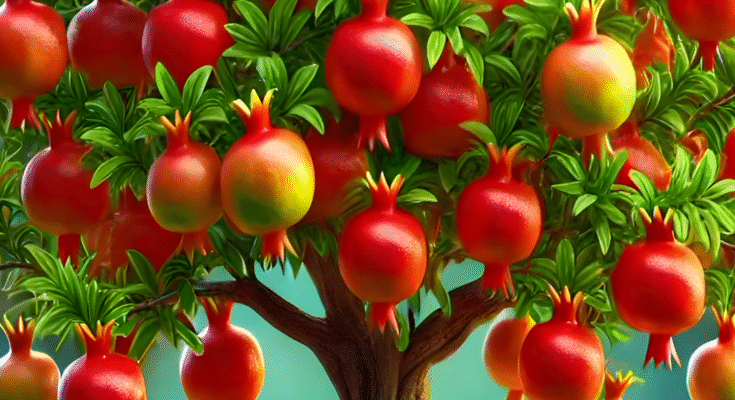Quick and Easy Method for Planting and Propagating Pomegranate Trees
Pomegranates are not only delicious and packed with nutrients, but they’re also one of the easiest fruit trees to grow at home. With their adaptability to various soil types and climates, pomegranate trees can thrive with minimal care when planted and propagated correctly. In this guide, we’ll explore a quick and easy method for planting and propagating pomegranate trees to ensure a healthy, fruitful harvest.
Why Grow Pomegranate?
Pomegranate (Punica granatum) is a hardy fruit tree known for its deep red fruits filled with juicy, sweet-tart seeds. Rich in antioxidants, vitamins C and K, and fiber, pomegranates offer both health benefits and a source of income for small farmers and home gardeners. The tree is drought-tolerant, disease-resistant, and can live for over 50 years when properly maintained.
Choosing the Right Location
For best results, select a planting location with the following characteristics:
- Full Sun: Pomegranate trees need at least 6–8 hours of sunlight per day to produce sweet fruit.
- Well-Drained Soil: Although they can tolerate poor soils, they perform best in loamy or sandy soils with good drainage.
- Air Circulation: Space your trees 10–15 feet apart to encourage airflow and prevent disease.
Quick Planting Method
Here’s a fast, effective way to plant a young pomegranate tree:
- Dig the Hole:
- Dig a hole twice as wide and just as deep as the tree’s root ball.
- Loosen the soil around the hole to allow easy root expansion.
- Prepare the Soil:
- Mix compost or aged manure into the excavated soil for better fertility.
- Avoid using chemical fertilizers at the planting stage.
- Plant the Tree:
- Remove the pomegranate tree from its container and gently loosen the roots.
- Place it in the center of the hole with the top of the root ball level with the ground.
- Fill the hole with the enriched soil and gently firm it down.
- Water Thoroughly:
- Water deeply after planting to settle the soil and eliminate air pockets.
- Continue watering 2–3 times per week for the first few months.
Easy Propagation Methods
There are two primary ways to propagate pomegranate trees quickly and easily: cuttings and seeds. For quicker fruiting and true-to-type trees, cuttings are the preferred method.
1. Propagation by Cuttings (Fastest and Most Reliable)
This method ensures that the new tree retains the qualities of the parent plant.
Steps:
- In early spring or late winter, select 8–10 inch hardwood cuttings from a healthy tree.
- Cut just below a node using clean, sharp pruning shears.
- Remove any leaves or flowers from the cutting.
- Dip the cut end in rooting hormone (optional, but improves success).
- Plant the cutting in a pot filled with moist sand or a mix of soil and compost.
- Water lightly and place in a warm, bright area (but out of direct harsh sun).
- In 6–8 weeks, roots should develop. Transplant to the garden once strong roots are visible and the plant begins new growth.
2. Propagation by Seeds (Slower, Less Reliable)
Seed-grown pomegranates can be fun for experimentation, but they may not produce fruit identical to the parent.
Steps:
- Scoop out seeds from a ripe pomegranate and wash off the pulp.
- Allow seeds to dry for 24 hours.
- Plant in a pot or seed tray with light potting soil.
- Keep moist and place in a warm location.
- Germination occurs in about 4–6 weeks.
- Transplant to the ground when seedlings are about 6 inches tall.
Caring for Young Trees
Once your pomegranate tree is in the ground or successfully propagated, follow these care tips:
- Watering: After establishment, water deeply once every 7–10 days. Pomegranates tolerate drought, but consistent moisture boosts fruit yield.
- Mulching: Apply a 2–3 inch layer of mulch around the base to retain moisture and suppress weeds.
- Pruning: Lightly prune during winter to remove dead or crossing branches. Shape the tree to a single trunk or multiple trunks depending on your preference.
- Feeding: Begin feeding the tree in its second year using compost or a balanced organic fertilizer during the growing season.
Pest and Disease Management
Pomegranate trees are generally resistant to pests and diseases, but watch out for:
- Aphids and whiteflies: Use neem oil or insecticidal soap.
- Fungal diseases: Avoid overhead watering and ensure proper spacing for airflow.
- Fruit splitting: Prevent this by maintaining consistent watering, especially during fruiting.
When to Expect Fruit
With good care, a pomegranate tree propagated by cuttings can start producing fruit within 2 to 3 years. Seed-grown trees may take up to 5 years or more. Harvest the fruit when it is deep red, heavy, and makes a metallic sound when tapped.
Final Tips for Success
- Choose disease-resistant, high-yielding varieties like ‘Wonderful’, ‘Parfianka’, or ‘Angel Red’.
- Avoid waterlogging; it’s one of the few things that can kill a pomegranate tree.
- Grow in pots if space is limited – just use a container at least 18 inches wide.
By following this quick and easy method for planting and propagating pomegranate trees, you’ll enjoy a bountiful harvest of sweet, nutritious fruits in just a few seasons. Whether you’re a beginner gardener or an experienced grower, pomegranates are a low-maintenance, high-reward addition to any garden or orchard.



